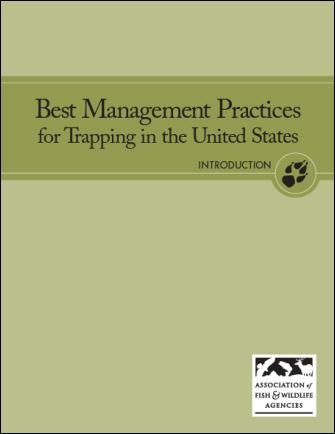
--Trappers conceived and produced every aspect of modern traps that prove to enhance humane treatment of animals. The BMPs tested, but did not create, the elements that make trapping humane.
---Trappers share the desire to be as humane as is conceivably possible in order to perpetuate sound wildlife management
---Trappers have and continue to invest their time, money, and effort to improve trapping techniques and tools, ultimately to accomplish a sustainable, humane management plan. Animal Rights groups spend their time, money, and effort elsewhere
--With direct trapper involvement, scientists have invested nearly nine million dollars in the BMP testing process to ensure that modern trapping tools are humane, efficient, and safe.
--Working to satisfy such entities as the International Standards Organization (ISO) and other worldwide recognized standards of humane treatment, modern trapping tools and techniques have been measured by the best possible science known to man, and have passed that inspection.
View BMPs
Best Management Practices (BMPs) for Trapping in the United States was written by the Furbearer Conservation Technical Work Group of the Association of Fish & Wildlife Agencies.
Traps were selected for testing based on their relative use among trappers surveyed by International Association of Fish and Wildlife Agencies (now Association of Fish and Wildlife Agencies) in 1992, 2004, and most recently in 2015-16.
Initially, the FTA Trapping Devices committee, under the direction of chairman Gary Jepson, felt that the BMP process was unnecessary, politically motivated, and a misallocation of resources.
The FTA has been, and continues to be actively involved at all BMP meetings and conferences.
No trapper objects to sound research that is designed to improve animal welfare and trapping efficiency. However, politics is an inevitable task master in such processes. The FTA also suggests that rarely does government involvement make the workplace more efficient.
With the recent completion of most of the original BMP testing documents, the objections to the process are now irrelevant, in that the processes have proceeded.
We repeat that the FTA has been directly involved with this process for decades now, and we would like to think that our efforts have had a positive impact on the products that are now published. We also feel that we have perhaps prevented developments that may have been damaging to the trapping world from becoming part of the process.
In summary, we did not support this effort’s creation; but did feel that it was better to be involved than to withdraw, and have the product produced without our input.
To date, nearly 9 million dollars have been invested in this process. Some of the early concerns trappers had of the process have not proven to have developed. On other concerns, the “jury is still out.” And admittedly, some of the results of the BMP testing have been good for trapping.
If trappers had a crystal ball and time machine so we could go to the future to see what the long range results would be, the decisions would be much easier; but this is not the case.
Every government project that has inertia needs some practical influence; projects like these need the “real world” influences to counter efforts that steer the project off course.
Occasionally this kind of influence is seen as “troublemaking, and obstructionist” and the FTA has been accused of this. We are far less concerned with critical labels than we are that outcomes truly are good for the future of trapping as we know it.
At this point, it only makes sense to point the public to the aspects of the BMPs that may be a positive influence for all concerned. The process is a reality, and making the best use of the good aspects of it seems sensible.
(After working with the members of the AFWA committee for many years, we have come to know most of the members as good people who are working with the best interest of trapping in mind. We may, and often do, disagree on what method might be in that best interest, but generally the AFWA Fur Resources Committee members are good people, doing what they think is best.)


